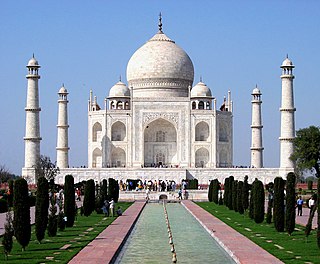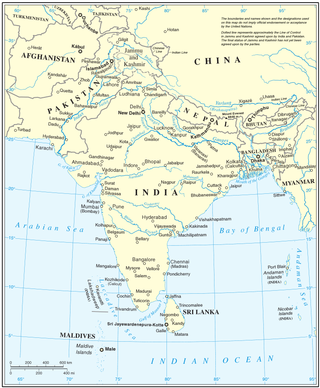
Anatomically modern humans first arrived on the Indian subcontinent between 73,000 and 55,000 years ago. The earliest known human remains in South Asia date to 30,000 years ago. Sedentariness began in South Asia around 7000 BCE; by 4500 BCE, settled life had spread, and gradually evolved into the Indus Valley Civilisation, which flourished between 2500 BCE and 1900 BCE in present-day Pakistan and north-western India. Early in the second millennium BCE, persistent drought caused the population of the Indus Valley to scatter from large urban centres to villages. Indo-Aryan tribes moved into the Punjab from Central Asia in several waves of migration. The Vedic Period was marked by the composition of their large collections of hymns (Vedas). The social structure was stratified via the varna system, which persists till this day though highly evolved. The pastoral and nomadic Indo-Aryans spread from the Punjab into the Gangetic plain. Around 600 BCE, a new, interregional culture arose; then, small chieftaincies (janapadas) were consolidated into larger states (mahajanapadas). A second urbanisation took place, which came with the rise of new ascetic movements and religious concepts, including the rise of Jainism and Buddhism. The latter was synthesised with the preexisting religious cultures of the subcontinent, giving rise to Hinduism.

The following outline is provided as an overview of and topical guide to the history of South Asia:

Muslim period in the Indian subcontinent is conventionally said to have started in 712, after the conquest of Sindh and Multan by the Umayyad Caliphate under the military command of Muhammad ibn al-Qasim. It began in the Indian subcontinent in the course of a gradual conquest. The perfunctory rule by the Ghaznavids in Punjab was followed by Ghurids, and Sultan Muhammad of Ghor is generally credited with laying the foundation of Muslim rule in Northern India.

The Delhi Sultanate or the Sultanate of Delhi was a late medieval empire primarily based in Delhi that stretched over large parts of the Indian subcontinent, for 320 years (1206–1526). Following the invasion of South Asia by the Ghurid dynasty, five dynasties ruled over the Delhi Sultanate sequentially: the Mamluk dynasty (1206–1290), the Khalji dynasty (1290–1320), the Tughlaq dynasty (1320–1414), the Sayyid dynasty (1414–1451), and the Lodi dynasty (1451–1526). It covered large swaths of territory in modern-day India, Pakistan, and Bangladesh as well as some parts of southern Nepal.

Indo-Persian culture refers to a cultural synthesis present on the Indian subcontinent. It is characterised by the absorption or integration of Persian aspects into the various cultures of modern-day republics of Bangladesh, India, and Pakistan. The earliest introduction of Persian influence and culture to the subcontinent was by various Muslim Turko-Persian rulers, such as the 11th-century Sultan Mahmud Ghaznavi, rapidly pushed for the heavy Persianization of conquered territories in northwestern Indian subcontinent, where Islamic influence was also firmly established. This socio-cultural synthesis arose steadily through the Delhi Sultanate from the 13th to 16th centuries, and the Mughal Empire from then onwards until the 19th century. Various Muslim dynasties of Turkic, local Indian and Afghan origin patronized the Persian language and contributed to the development of a Persian culture in India. The Delhi Sultanate developed their own cultural and political identity which built upon Persian and Indic languages, literature and arts, which formed the basis of an Indo-Muslim civilization.

The Lodi dynasty was a dynasty that ruled the Delhi Sultanate from 1451 to 1526. It was the fifth and final dynasty of the Delhi Sultanate, and was founded by Bahlul Khan Lodi when he replaced the Sayyid dynasty.

The history of Bengal is intertwined with the history of the broader Indian subcontinent and the surrounding regions of South Asia and Southeast Asia. It includes modern-day Bangladesh and the Indian states of West Bengal, Tripura and Assam's Karimganj district, located in the eastern part of the Indian subcontinent, at the apex of the Bay of Bengal and dominated by the fertile Ganges delta. The region was known to the ancient Greeks and Romans as Gangaridai, a powerful kingdom whose war elephant forces led the withdrawal of Alexander the Great from India. Some historians have identified Gangaridai with other parts of India. The Ganges and the Brahmaputra rivers act as a geographic marker of the region, but also connects the region to the broader Indian subcontinent. Bengal, at times, has played an important role in the history of the Indian subcontinent.

The Muslim conquests in the Indian subcontinent mainly took place between the 13th and the 18th centuries. Earlier Muslim conquests in the subcontinent include the invasions which started in the northwestern subcontinent, especially the Umayyad campaigns during the 8th century. Mahmud of Ghazni, Sultan of the Ghaznavid Empire, preserved an ideological link to the suzerainty of the Abbasid Caliphate and invaded vast parts of Punjab and Gujarat during the 11th century. After the capture of Lahore and the end of the Ghaznavids, the Ghurid ruler Muhammad of Ghor laid the foundation of Muslim rule in India in 1192. In 1202, Bakhtiyar Khalji led the Muslim conquest of Bengal, marking the easternmost expansion of Islam at the time.
Muslim Rajputs or Musalman Rajpoots are the descendants of Rajputs in the northern regions of the Indian subcontinent who generally are followers of Islam. Reportedly, they converted from Hinduism to Islam from the medieval period onwards, creating various dynasties and states while retaining Hindu surnames such as Chauhan. Today, Muslim Rajputs can be found mostly in present-day Northern India and Pakistan. They are further divided into different clans.

Delhi has been an important political centre of India as the capital of several empires. The recorded history of Delhi begins with the 8th century Tomar Rajputs kingdom. It is considered to be a city built, destroyed and rebuilt several times, as outsiders who successfully invaded the Indian subcontinent would ransack the existing capital city in Delhi, and those who came to conquer and stay would be so impressed by the city's strategic location as to make it their capital and rebuild it in their own way.

Rājputana, meaning Land of the Rajputs, was a region in the Indian subcontinent that included mainly the present-day Indian state of Rajasthan, as well as parts of Madhya Pradesh and Gujarat, and some adjoining areas of Sindh in modern-day southern Pakistan.

The History of Karnataka goes back several millennia. Several great empires and dynasties have ruled over Karnataka and have contributed greatly to the history, culture and development of Karnataka as well as the entire Indian subcontinent. The Chindaka Nagas of central India Gangas, Rashtrakutas of Manyakheta, Chalukyas of Vengi, Yadava Dynasty of Devagiri were all of Kannada origin who later took to encouraging local languages.

The political history of medieval Karnataka spans the 4th to the 16th centuries in Karnataka region of India. Previously foreign empires held sway over the region, and the nucleus of power was outside modern Karnataka. The medieval era can be broadly divided into several periods: The earliest native kingdoms and imperialism; the successful domination of the Gangetic plains in northern India and rivalry with the empires of Tamilakam over the Vengi region; and the domination of the southern Deccan and consolidation against Muslim invasion. The origins of the rise of the Karnataka region as an independent power date back to the fourth-century birth of the Kadamba Dynasty of Banavasi, the earliest of the native rulers to conduct administration in the native language of Kannada in addition to the official Sanskrit. This is the historical starting point in studying the development of the region as an enduring geopolitical entity and of Kannada as an important regional language.

The history of Madhya Pradesh can be divided into three periods - the ancient period, the medieval period and modern period.
Hindu Rajput kingdoms in the north-western Indian subcontinent resisted the Muslim invasions of India, beginning with the Umayyad campaigns from the Middle East and the Ghaznavid Turks from Central Asia. They continued resistance against subsequent Muslim empires, including the Arabs, Ghaznavids, Ghurids, Delhi Sultans and the Mughals.

The history of Uttar Pradesh, a state in India, stretches back several millennia. The region shows the presence of human habitation dating back to between 85,000 and 73,000 years ago. Additionally, the region seems to have been domesticated as early as 6,000 BC.

Islam is the second-largest religion in South Asia, with more than 640 million Muslims living there, forming about one-third of the region's population. Islam first spread along the coastal regions of the Indian subcontinent and Sri Lanka, almost as soon as it started in the Arabian Peninsula, as the Arab traders brought it to South Asia. South Asia has the largest population of Muslims in the world, with about one-third of all Muslims living here. Islam is the dominant religion in half of the South Asian countries. It is the second largest religion in India and third largest in Sri Lanka and Nepal.













